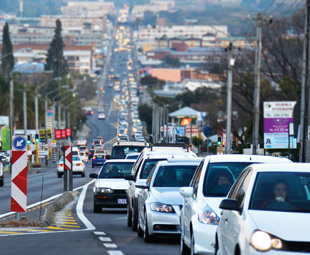Looking ahead

What might the future hold for the transport sector in South Africa?
According to a study put together by H.J. Stander and J.C. Brink, being a developing middle-income country, South Africa has considerable transportation challenges. Car ownership and use are rising with improved economic conditions, but congestion on the road network is worsening all the time. Retaining public transport users is costing more in the form of operating and capital subsidies.
The road-safety situation is poor when compared to international benchmarks, and can be considered a national crisis. The purpose of their study was to illustrate current trends and to provide some perspective on where South Africa could be heading with respect to these issues. These were some of their findings:
In many of our cities the modal split of motorised trips is approximately 50/50 between private and public transport trips on a daily basis. For workers, the countrywide modal split on a daily basis was 40/40/20 (public transport/private transport/walking) according to the 2013 National Household Travel Survey.
Car ownership has increased with new car sales reaching record figures every year. Currently, around 600 000 new cars are sold every year and the number of registered vehicles has increased at a relatively high rate since 2004.
The number of registered vehicles grew at four percent per annum (on average) over the ten-year period from 2004 to 2014. This is much higher than the population growth and also higher than the growth of the economy in real terms.
It is accepted that these numbers include cars, trucks, tractors and trailers (most, but not all vehicles are motorised). The National Household Travel Survey confirmed that the households that owned, or had access to cars increased from 22,9 percent in 2003 to 28,5 percent in 2013.
Annual new vehicle sales in South Africa show a decline since 2013 (2015 shows a 4,1 percent decline when compared with 2014). However, due to the increase in vehicles being exported, the domestic production of motor vehicles is expected to show an increase from 615 000 units in 2015 to 660 000 in 2016.
According to the National Association of Automobile Manufacturers of South Africa (Naamsa), the official motor industry vision is to produce around one million new vehicles in South Africa by 2020.
Between 2004 and 2014, the average increase in the number of people with driving licences has been 4,45 percent per annum, which is even higher than the growth in registered vehicles.
This confirms the relatively high growth in motorisation that is taking place (with the resultant impact on road needs and capacity). The total number of people with driving licences is almost equal to the number of vehicles registered.
The taxation of private road users is an important source of revenue for Treasury (estimated to be at least 7,5 percent of tax revenue) and it is expected to be the case for the foreseeable future.
The promotion of modal shift towards public transport, and the introduction of high-standard services, such as bus rapid transit systems and the Gautrain, do introduce challenges with respect to financial sustainability, and the current subsidy situation is considered “not sustainable” by some.
Currently, the minibus-taxi industry is, in fact, the most important element of public transport services in the country and, by transporting 70 percent of workers, is saving government huge amounts in subsidies.
Even though many South African cities have densification policies, real densification is taking place slowly and limited success can be expected – at least when compared with other high-density cities in the world such as those in South America and China.
Congestion is costing road users dearly in terms of time lost in traffic. It appears that there are limited funds available to attend to this, and the situation can be expected to worsen substantially, unless more funds become available for creating road capacity.
The state of our transportation infrastructure is considered to be good when compared with many other developing countries, but only fair when compared with developed nations. The South African National Roads Agency Limited (Sanral) indicated in 2014 that the maintenance backlog of the 750 000-km South African road network was R197 billion at that time.
No plan to address this backlog has ever been developed (as far as is known), which implies that South Africa will not be in a position to maintain all of its roads to ideal standards.
Even the rail commuter network, which has been the focus of upgrading and “increased” investment for a number of years now, shows little improvement in practice. As an example, the daily number of passengers boarding the suburban rail service in Cape Town decreased from 675 000 in 2000 to
621 000 in 2012.
Although some improvement in the road safety situation in South Africa has occurred in the past decade, when compared to other countries, it has to be said that the country’s road safety situation is still totally unacceptable.
To turn around the current situation will not be easy and remains a huge challenge for the authorities responsible for the management of major roads. Drastic measures are now required.
Published by
Focus on Transport
focusmagsa




